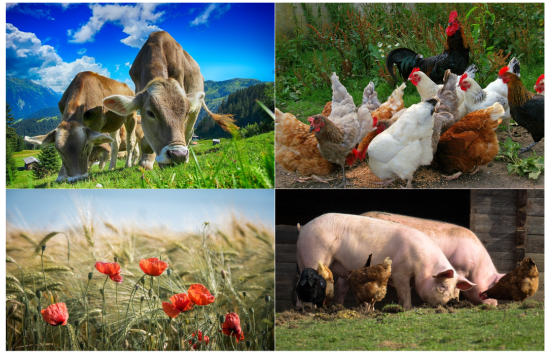Real-Time Biological Research with PTR-MS

Image Credit: IONICON Analytik
The range of benefits of PTR-MS is especially useful for livestock and agricultural research. From VOCs emerging from sheep, chicken, pigs, or cattle to agricultural field emissions, there are hardly any applications that have not been analyzed in great detail with the highly sensitive PTR-MS technology.
Research about the biological applications of PTR-MS is also being actively supported by IONICON. For example, through its industrial CASE studentship, “On-line detection and diagnosis of plant damage and stress by herbivores and pathogens” and its collaboration with the FP7-IAPP project ‘PTR-TOF’.
The collective experience assists IONICON in supporting its customers in biological research and producing more advanced products.
Plant Studies
Direct injection with no requirement for sample preparation and its real-time functionality are two of the most noteworthy advantages of PTR-MS. These are critically important when analyzing and monitoring VOCs emitted after plant damage.
Environmental scientists in the laboratory normally place whole plants or leaves in cuvettes as a means to analyze emitted trace gases. Several large-scale investigations including plowed soil, woodland, crops, or grassland have also been carried out to great success.
Plant damage can arise because of several factors: herbivore attacks, harvesting and mowing, weather damage, mechanical wounding, and also different kinds of stress (such as high ozone levels, extreme temperatures, and drought).
As the release of VOCs due to plant damage is normally a highly dynamic and rapid process, traditional off-line techniques are inappropriate as they are incapable of analyzing the actual process in its entirety, and can only analyze snapshots.
The emitted VOCs can be directly investigated with PTR-MS, with high selectivity, sensitivity and at time resolutions of up to 10 Hz.
One of the first examples of a regular plant investigation was published by Brilli et al. in 2011. Biogenic VOCs generated after light or dark changing and leaf wounding were analyzed in detail.
The researchers explained that, "PTR-TOF measurements unambiguously captured the kinetic of the large emissions of green leaf volatiles (GLVs) and acetaldehyde after wounding and darkening" and they even found a unique class of C5 compounds in biogenic VOC emission induced by wounding.
M. Held and T. Turlings (Université de Neuchâtel) demonstrated that when caterpillars attack plants, the plant emits distinct VOCs. Found in caterpillar saliva, Volicitin generates defense genes that result in the creation of indole and additional VOCs which entice wasps. As caterpillars are used by wasps in their reproduction cycle, the wasps ensure that the plant comes to no harm.
Schausperger et al. employed an IONICON PTR-TOFMS instrument to study the effects of a mycorrhizal fungus on the chemical composition of herbivore-induced plant volatiles (HIPVs). These HIPVs are generated by bean plants in response to spider mite attacks, but the natural enemy of the spider mites are attracted to these HIPVs.
They stated, "Our study provides a key example of an adaptive indirect HIPV‐mediated interaction of a below‐ground micro‐organism with an above‐ground carnivore."
These are only a few case studies from the hundreds of cutting-edge plant experiments which have been made viable with the exclusive IONICON PTR-MS technology.
IONICON is pleased to offer its customers with a personal showcase customized to their plant study application. This will also cover which IONICON PTR-MS instrument and which add-ons will make the ideal combination to meet the customer’s requirements.
Stock Farming
Livestock facilities are an essential part of the meat supply chain. Pungent emissions from rigorous livestock production can be a contentious issue in rural locations.
The research team around A. Feilberg (Aarhus University, Denmark) carried out detailed studies on the release of odorant compounds utilizing IONICON PTR-MS technology.
In one of their first reports, they stated, "PTR-MS measurements has for the first time enabled insights into the temporal variation in emissions of odorants from intensive pig production."
A more recent publication by Aarhus University investigated photocatalytic degradation of odorous compounds (four volatile fatty acids, 1-butanol, four reduced sulfur compounds).
They explained, "It has been demonstrated that PTR-MS is a useful tool for researching photocatalysis, and the results of this study can be used to optimize photocatalysis in the reduction of emissions of offensive odors in realistic conditions."
M. Dunlop (University of New South Wales, Australia) recently published a PhD thesis where a TOF based IONICON PTR-MS instrument was used to investigate odor emissions from poultry litter.
An important discovery of this study was that the emission rates of certain odorants were strongly influenced by the condition of the chicken litter, for example if the litter was dry or wet. Dunlop explains in his thesis that the IONICON PTR-TOF 1000 facilitated the quantification of VOC concentrations in real-time.
This is a key advantage that would not have been possible with traditional standard techniques like TD-GC-MS. Odor activity values and odorant emission rates could also be determined utilizing the PTR-MS data.
A host of other functions of animal husbandry have been investigated with PTR-MS instruments, often resulting in pioneering results.
Whether the influence of dairy cattle emissions on ozone formation or the composition of VOCs emitted from sheep sheds are to be studied, a large majority of researchers have always depended on the unrivaled IONICON technology with its range of accessories, add-ons, and the patented TRU-E/N ion-chemistry quality.

This information has been sourced, reviewed and adapted from materials provided by IONICON Analytik.
For more information on this source, please visit IONICON Analytik.